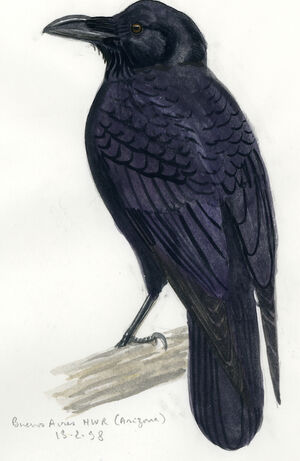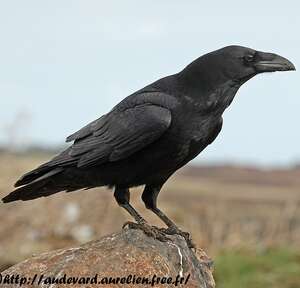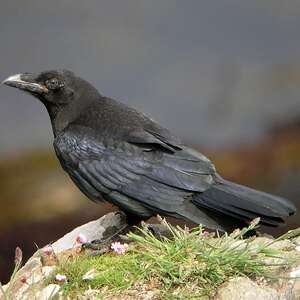Northern Raven
Corvus corax - Grand Corbeau
Identification
The Northern Raven is the largest passerine in the world. To compare, it is larger and heavier than a Common Buzzard and has a greater wingspan. Therefore, it is significantly larger than the Common Raven or the Carrion Crow that it superficially resembles. Most of the time, when it's flying, you can first recognize it by its voice, which is quite particular, and then by its silhouette, which is also quite particular, with its long wings and long cuneiform tail.
When it's perched, it is its black beak that attracts attention and gives its identity. It is strong, long and high, making the head appear smaller. It almost seems to fill the entire face. The culmen, which can reach a length of 8 cm and a height of 2.5 to 3 cm, is steadily curved and pointed at the end. The base half is covered with nasal bristles. The gonys is straight and slightly lifted at the end to form a hook. The top of the skull is often curved, reminding of the Common Raven. The iris is dark brown and the eye is surrounded by a faint grey circle.
The plumage is completely black and glossy, with bluish reflections in the sun. The legs, which are strong, are also black. The male is slightly bigger and stronger than the female. The juvenile is black, but without the gloss and with a noticeable brownish hue in the light.
Subspecific information 11 subspecies
- Corvus corax corax (nw Europe through c Europe to c Siberia)
- Corvus corax principalis (Alaska, Canada. except the sw. , Greenland and n and e USA)
- Corvus corax sinuatus (sw Canada through wc USA to Mexico and Nicaragua)
- Corvus corax clarionensis (sw USA and nw Mexico)
- Corvus corax varius (Iceland and Faroe Is.)
- Corvus corax hispanus (Iberian Pen., Italy and Mediterranean islands)
- Corvus corax laurencei (Greece, Cyprus and Turkey to w China and n India)
- Corvus corax tingitanus (n Africa)
- Corvus corax canariensis (Canary Is.)
- Corvus corax tibetanus (c Asia)
- Corvus corax kamtschaticus (w Mongolia, e Siberia, ne China, n Japan and nearby islands)
Foreign names
- Grand Corbeau,
- Cuervo grande,
- corvo-comum,
- Kolkrabe,
- holló,
- Raaf,
- Corvo imperiale,
- korp,
- Ravn,
- krkavec čierny,
- krkavec velký,
- Ravn,
- korppi,
- corb comú,
- Hrafn,
- kruk (zwyczajny),
- krauklis,
- krokar,
- Ворон,
- ワタリガラス,
- 渡鸦,
- korp,
- 渡鴉,
Voice song and call
The Northern Raven is not stingy with its voice. When it is present at a place, it cannot be missed from more than a kilometer away.
The usual call is a loud and coarse r r a a a k, of variable pitch, but usually high. The call is usually doubled. It has territorial value, among others.
The frequency of notes can vary. When the bird is calm, the frequency is lower and the call softens to crroook. On the other hand, when the bird is excited, the notes stand out and crackle.
This call has no equivalent in Europe at least. The repertoire is rich with cries, varying according to context, but always dry and seeming to be sounds obtained by percussion of wooden objects.
Habitat
The Northern Raven is a generalist, living in a variety of environments from the tundra and boreal forest in the north to arid or semi-arid habitats in the south, including steppe, medium and high mountains, coastal areas, agricultural areas, etc.
Depending on the local conditions, it nests in rocky areas or trees. This is the standard in Europe. When possible it prefers the former as it offers better protection, provided there is no human disturbance. Nesting on a large tree is increasingly becoming more common.
Elsewhere in the world, conditions vary. In addition to the two aforementioned cases, Northern Ravens may nest on an electrical pylon, derrick, bridge, old buildings, etc., anthropogenic supports clearly showing the species' adaptability. This is mainly the case in the New World.
However, food is primarily sourced in open areas. It is a well-known opportunistic necrophage, but also an omnivore. It roams agricultural spaces, roadways due to mortalities, and dumps and landfills. It avoids urban areas, as if it still remembered past misfortunes.
Behaviour character trait
At the Northern Raven, a frequent behavior in the family is gregarism, the tendency to gather together, during the day to take care of daily occupations and during the night to sleep together in dorms. This behavior can only be observed in adults outside the breeding season when they defend a territory. On the other hand, immature and unemployed birds stay gregarious year-long. We can then observe groups of several dozen birds, a bit like with the Common Raven. It has nothing to do with what can be observed in the Carrion Crow: sometimes hundreds, even thousands of birds.
The difference can be explained by the importance of migration. The Northern Raven, like the Hooded Crow, is sedentary whereas the Carrion Crow is a migratory.The Northern Raven adult spends its life on its territory or in its vicinity. It is the young birds which make sure to mix up the population by looking for a new territory or an unoccupied one.
There is a rather surprising character trait of the species and which has a social function, it is the acrobatic flight it frequently practices all year long. It must be a question of dominance within the group or between couples. The bird in flight quickly passes on its back, wings glued to its body, then comes back to its initial position while yelling out loud. The half barrel roll is the most frequent but sometimes it is a whole barrel roll. It is very spectacular. Maybe it is only the males who do it? The problem has not been solved yet.
Territoriality is strong during nesting. Any eventual intruders are quickly pursued and lead until the border of the territory with loud screams.
Flight
The Northern Raven is very comfortable in flight. Its long, powerful muscled wings provide it with a swift and noisy beat flight which it uses, for example, to expel intruders from its territory.
Its display and territorial demonstration flights are often acrobatic. It is able to do complete barrel rolls on its wing.
It also practices soaring flight whenever possible. In the presence of favourable thermals, the couple take advantage of them to circle overhead the territory up to great heights, like the soaring raptors.
Dietfeeding habits
Northern Raven is an omnivore, heavily into necrophagy. It is an attentive observer of its environment and available resources.
Like a kite, it looks for animal carcasses killed on the road. It frequents active manure piles, landfills where they still exist and spreading areas.It carefully watches wildlife births in the wild, such as lambing, to consume placentas and even stillborns, which is why it is not well-liked by farmers.
It is also a predator which can catch small vertebrates and invertebrates at the ground level, much like a Carrion Crow.
Bird breeding colonies also attract it. It is known, for example, to loot the nests of species nesting on coastal cliffs such as the Black-headed Gull and take what is due: eggs or chicks. It often nests near a Grey Heron breeding colony seeking out infertile eggs, weak chicks and fishes brought to the nest by adults, some of which escape from the herons and are a delight for the corvid.
It also hides surplus food for lean days.
In the presence of an intact corpse, it is very careful, much preferring an already opened one. It will only feed if it is convinced that there is no danger to itself.
Reproduction nesting
Throughout Europe, the Northern Raven has its nesting sites located in rocky cliffs, natural or not, or in tall trees. The nest is a large bundle of twigs, well secured onto a rocky ledge or in the fork of a tree, providing an inner bowl lined with soft materials such as sheep wool, furs, grass, moss, paper... This bowl often strengthened with mud, as it is a habit among corvids. The nest may be reused from year to year and renovated for this purpose. It also sometimes happens that the Northern Raven settles into an old nest of another kind of bird, such as a raptor or a colonial species like the Grey Heron.
The Northern Raven is a sedentary, monogamous species. It starts off reproducing at the age of 3 years old. The reproduction season begins at the end of winter with displays of sex by the couple, who reinvest in its territorial defence, building or repairing the nest and reestablishing their bond. This is expressed through acrobatic territorial flights above the nesting site. The couple also have ground displays, with the throat feathers bristling up. The male spreads his wings and tail, holds his neck up while curving, but keeps the beak directed towards the ground. The female invites him to mate by crouching.
The Northern Raven lays its eggs early among the species. From the Northern part down to the Southern part of its range, this happens between early March and mid-April. The female lays three to seven pale, spotted eggs which she incubates alone for eighteen to twenty-one days. She is fed by the male during this time. The chicks are brooded upon hatching covered in scanty down. The parents feed them through regurgitation from their food pouch into the chick's throat. They may do the same with water. The juveniles leave the nest five to seven weeks after hatching, still staying with them for a certain amount of time, before joining the groups of junior and immatures from the area. There is only one clutch per year.
Geographic range
The Northern Raven has a Holarctic distribution. It is present on the North American continent, Greenland, Iceland, the British Isles and throughout the Eurasian continent. It extends southwards to Central America up to Costa Rica and to the northern part of the African continent, mainly the Maghreb, and the Canary Islands. It is sedentary. Ten subspecies are described with slight differences between them.
Threats - protection
IUCN conservation status
concern
in the Wild
threatened
evaluated
The Northern Raven is not an endangered species. It has a very wide distribution and is often locally common or even abundant, especially in America. It is at the end of the food chain and is often necrophagous. That is why it is easy to reduce the number of Northern Ravens by poison. Indeed, it has long been, and still is locally, considered undesirable in agriculture because of its damage to young livestock, eggs and chicks of outdoor farms, etc., again mainly on the American continent. Currently, balance is sought rather than eradication.
In Europe, the Northern Raven must have been ubiquitous in the past, then hunted until its eradication in the plain as soon as man had the technical means to hunt it (gun) because of its very bad reputation. It is known that it attacked human corpses during the wars, probably starting by pulling out the eyes. It then disappeared from the plain to take refuge in the mountains. This is particularly clear in France, where the current situation is the reflection of this fateful past. It is present, but never in large numbers, in all our mountain ranges and only begins today to go back to the conquest of the plain. It has few natural predators, mainly the European Eagle-Owl in rocky areas and perhaps the Pine Marten in forests. It is a species protected by law.
Sources of information
- IOC World Bird List (v15.1), Gill, F and D Donsker (Eds). 2025-12-07.
- Les passereaux d'Europe, tome 1, P. Géroudet, M. Cuisin
- Birds of the World, The Cornell Lab of Ornithology
- xeno-canto, Sharing bird sounds from around the world,
Other sources of interest
 Specification sheet created on
02/07/2023 by Jean François
Specification sheet created on
02/07/2023 by Jean FrançoisTranslation by AI Oiseaux.net
© 1996-2025 Oiseaux.net
- Accipitriformes
- Aegotheliformes
- Anseriformes
- Apodiformes
- Apterygiformes
- Bucerotiformes
- Caprimulgiformes
- Cariamiformes
- Casuariiformes
- Charadriiformes
- Ciconiiformes
- Coliiformes
- Columbiformes
- Coraciiformes
- Cuculiformes
- Eurypygiformes
- Falconiformes
- Galliformes
- Gaviiformes
- Gruiformes
- Leptosomiformes
- Mesitornithiformes
- Musophagiformes
- Nyctibiiformes
- Opisthocomiformes
- Otidiformes
- Passeriformes
- Pelecaniformes
- Phaethontiformes
- Phoenicopteriformes
- Piciformes
- Podargiformes
- Podicipediformes
- Procellariiformes
- Psittaciformes
- Pterocliformes
- Rheiformes
- Sphenisciformes
- Steatornithiformes
- Strigiformes
- Struthioniformes
- Suliformes
- Tinamiformes
- Trogoniformes



































